Built from granite from the neighboring cliffs, the Flamanville church is steeped in history.
Dedicated to Saint-Germain also known as Le Scot, this Scotsman arrived in 429 to evangelize the region. According to legend, he came to Diélette on a wheel-shaped boat and killed a monster that was terrorizing the country, in a cave called Baligan.
Subsequently, a chapel and then a church were built in Diélette in his name near Mont Saint-Gilles.
As this church was quite far from the centrer of the parish and the castle, it was decided to build a new one, the present. In his will, the castellan Hervé Basan provides a donation to build a new church. He died in 1966, and his widow, who died in 1669, also bequeathed funds and stipulated that the local population should build the new church. This massive project extends over a year, including quarrying and processing the granite on site, transporting it, building the walls and installing the roofs. The church was consecrated for Christmas in 1670.
Cruciform in plan, the church of Flamanville has several particularities: a small vaulted chapel dedicated to Sainte-Barbe, patron saint of miners, a bell tower in the shape of a square tower, wooden statues from the 17th and 18th centuries, baptismal funds from the 13th century, stained glass windows dedicated to Saint-Germain, a relic of which remains inside the church, a relic of Sainte-Réparate, a Roman martyr from the 3rd century, and a pavement made up of old tombstones with nimbed crosses.
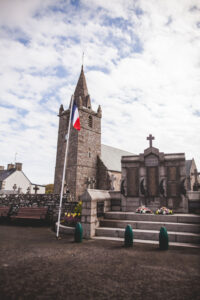
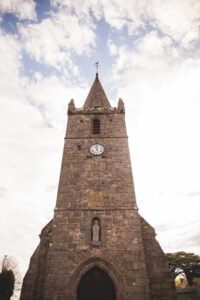
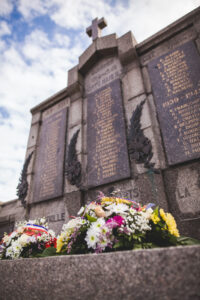
A. Bell tower-porch
B. Nave
C. Ste Barbe Chapel
D. St Sébastien Chapel
E. Transept crossing
F. Small side chapel
G. Choir
H. Sacristy
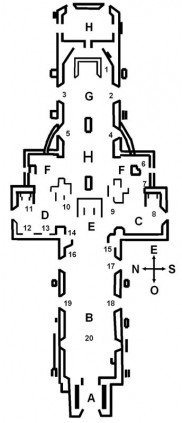
1. Sanctuary pool, granite – 1669.
2. Glass roof: Saint Louis, King of France – painted glass around 1880-1890.
3. Glass roof: Saint Paul, apostle – painted glass around 1880-1890.
4. Glass roof: St James the Greater, pilgrim – painted glass around 1880-1900.
5. Glass roof: crucifixion with the Magdalene at the foot of the cross – glass painted around 1880-1900.
6. Baptismal font and its cover. Partitioned granite tank resting on four granite corner columns and a central limestone column, 17th century.
7. Eagle lectern – polychromed and gilded oak wood – early 18th century.
8. South side altar, tabernacle, altarpiece with two columns and four pilasters, entablature – Partially gilded natural oak wood – 19th century.
9. Statue: St Germain bishop. Pickled wood – 18th century.
10. Statue: Virgin and Child. Stripped (lime?) wood – late 17th century.
11. North side altar – Oak wood – 19th century.
12. Painting and its frame: the Annunciation – oil painting on canvas (table) and painted wood – 19th century.
13. Banner of St Germain le Scotus – second half of the 19th century.
14. Pulpit to preach. Oak wood – 18th century.
15. Sculpted group: Saint Thomas putting his fingers in the wound of Christ – Pickled and waxed oak wood – 17th century.
16. Statue: Saint Mary Magdalene. Stripped oak wood – late 17th century.
17. Emblazoned epitaph of Agnès Bonnemain, wife of Jacques de la Chapelle. Limestone – circa 1687.
18. Glass roof: arrival at Diélette from St Germain to la rouelle, Painted glass, 1926 by H.Mazuet in Bayeux.
19. Glass roof: St Germain le Scotus chaining the dragon in the Baligan hole. Painted glass, 1926 by H.Mazuet in Bayeux.
20. Forty-two tombstones with haloed crosses reused as paving in the church between 1718 and 1722 – granite.
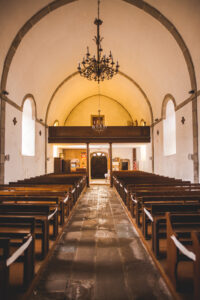
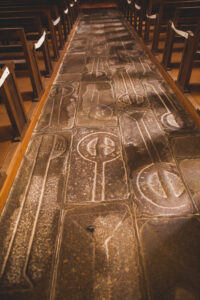
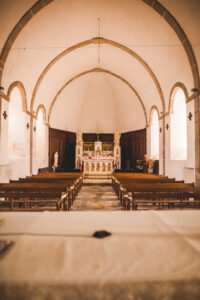
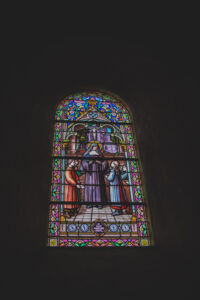
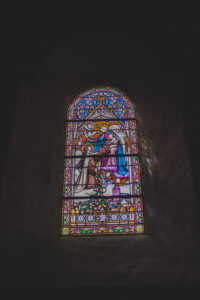
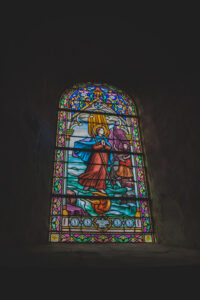
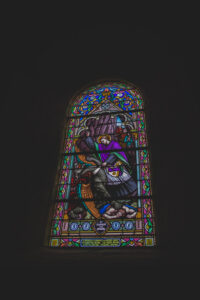
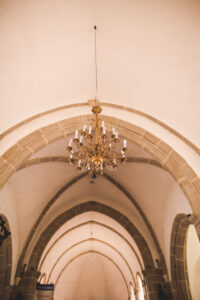
Every day, from 8:30 a.m. to 5:30 p.m.
9:45 a.m.: Alternatively in one of the four churches other than Flamanville (Héauville, Helleville, Siouville or Tréauville).
11:00 a.m.: Flamanville.
Presbytery of Flamanville
+33 (0)2 33 52 48 35